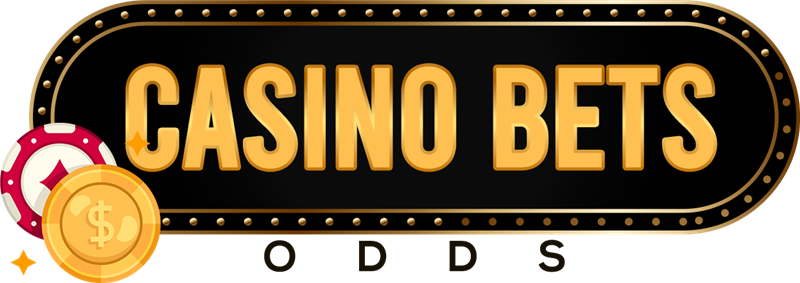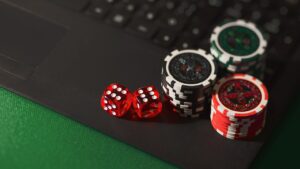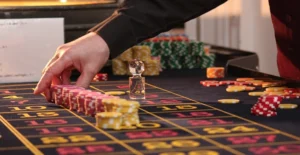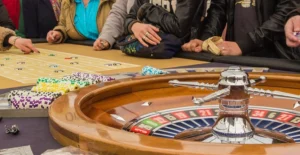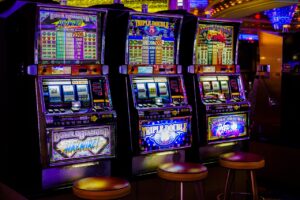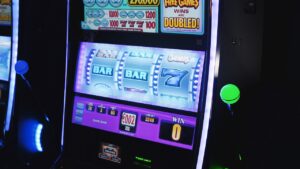Ever wondered how many card decks are used in blackjack? It’s a question many players ask, and it matters more than you might think. Blackjack is super popular, and knowing about the decks can even help your game. Let’s break down why casinos use different numbers of decks and what that means for you when you’re at the table.
Key Takeaways
- Casinos use more decks now to make the game fair and keep things moving.
- Most blackjack games today use between six and eight decks.
- More decks make it harder for players to count cards and help the casino keep its slight edge.
- Single-deck games can be better for players, but casinos often change other rules to balance them out.
- You can usually figure out the deck count by looking at the shoe or just asking the dealer.
Understanding How Many Card Decks Are Used in Blackjack

The Evolution of Deck Usage in Blackjack
Blackjack, a casino staple, wasn’t always the multi-deck game it is today. Originally, it was played with a single deck blackjack game. This simplicity made it easier to follow the game, but also more vulnerable to certain strategies. As the game evolved, so did the number of decks used, largely in response to players finding ways to gain an edge.
Why Casinos Increased Deck Numbers
Casinos started increasing the number of decks primarily to make card counting more difficult. A single-deck game is much easier to track than a game with multiple decks. By adding more decks, the complexity increases exponentially, making it harder for players to keep an accurate count. This shift was a direct response to players who were successfully using card counting to improve their odds.
Impact of Deck Count on Game Fairness
Increasing the number of decks has a direct impact on the house edge. While it makes card counting harder, it also slightly shifts the odds in favour of the casino. The change isn’t massive, but it’s enough to make a difference over time. Regulations are in place to ensure game fairness, but the deck count is one factor that casinos can adjust to influence their profitability.
The move to multiple decks wasn’t just about foiling card counters. It also streamlined the game. Shuffling less frequently means more hands per hour, which translates to more profit for the casino. It’s a balancing act between fairness, game speed, and profitability.
The Standard Number of Decks in Modern Blackjack
Common Deck Counts in Casinos Today
So, you’re wondering how many decks are typically used in blackjack these days? Well, it’s not a one-size-fits-all answer, but most casinos use between six and eight decks in their blackjack games. This has become the standard for a few reasons, which we’ll get into later. You might occasionally find games with fewer decks, but those are becoming less common, especially in larger casinos. It’s all about balancing the game for both the player and the house.
Variations in Deck Numbers Across Venues
Okay, so while six to eight decks is the norm, you’ll see some variation depending on where you’re playing. For example:
- Las Vegas Strip: Often uses six or eight decks.
- Smaller casinos or local gambling spots: Might use two or four decks.
- Online Blackjack: Can vary wildly, with some games even simulating continuous shuffling.
It’s always a good idea to check the specific rules of the table before you start playing. The number of decks used can impact your strategy, so being aware is key.
How Many Card Decks Are Used in Blackjack: The Typical Range
To nail it down, let’s talk about the typical range. While single-deck games exist, they’re increasingly rare because of card counting concerns. Most casinos stick to multiple decks to make things a bit more challenging for players trying to gain an edge. You’ll find that the number of decks used affects the house edge, so it’s something to keep in mind. Here’s a quick rundown:
- Single-Deck: Very rare, often with less favourable rules.
- Double-Deck: Less common, but still found in some casinos.
- Four-Deck: A middle ground, sometimes seen in smaller venues.
- Six-Deck: Very common, a standard in many casinos.
- Eight-Deck: Also very common, especially in larger casinos with high table limits.
So, next time you sit down at a blackjack table, take a peek at the shoe and see how many decks are in play! It’s a small detail that can make a difference in your game.
Reasons Behind Multiple Decks in Blackjack
Casino Efficiency and Game Flow
Casinos adopted multi-deck games partly for efficiency. Shuffling takes time, and time is money in a casino. Using multiple decks allows for more hands to be dealt between shuffles, speeding up the game and increasing the profit potential. With single-deck blackjack, the dealer would have to shuffle after almost every round. This is simply not efficient when you have many players at the table. More decks mean less shuffling, which translates to more hands per hour.
Mitigating Card Counting Strategies
One of the primary reasons casinos use multiple decks is to make card counting more difficult. Card counting, while not illegal, is frowned upon by casinos because it can shift the odds in the player’s favour. The more decks in play, the harder it is for a card counter to keep track of the cards and accurately predict the likelihood of certain cards being dealt. This is because the ratio of high to low cards becomes harder to estimate as the number of cards increases. This is why casinos will use blackjack strategies to counter card counting.
Maintaining the House Edge
Casinos are, after all, businesses, and they need to maintain a house edge to ensure profitability. While single-deck blackjack generally offers better odds for the player, casinos can adjust the rules to compensate, such as restricting doubling down or increasing the minimum bet. However, using multiple decks provides a more straightforward way to increase the house edge without significantly altering the rules. The increased complexity makes it harder for players to gain an advantage, thus helping the casino maintain its profit margin. The house edge rises with every deck added.
Think of it like this: imagine trying to guess the number of red marbles in a jar. If there are only 10 marbles, it’s a pretty easy guess. But if there are 1000 marbles, it becomes much harder. More decks in blackjack are like adding more marbles to the jar, making it harder for players to predict what’s coming next.
The House Edge and Deck Count in Blackjack
How More Decks Affect the House Advantage
So, how does the number of decks change things for the casino? Well, it’s all about probability. More decks generally mean a higher house edge. This is because it reduces the player’s chances of getting a natural blackjack (an Ace and a 10-value card), which pays out at 3:2. It also makes it harder to predict what cards are coming next, which is bad news for players trying to use basic strategy or card counting. The increase isn’t huge, but it’s enough to make a difference over the long haul. You can use a blackjack calculator to see the exact impact.
Mathematical Implications of Deck Numbers
The math behind it can get pretty complex, but here’s the gist. When you have fewer decks, the removal of each card has a bigger impact on the remaining deck composition. This means that if a lot of low cards have been dealt, the odds of getting a high card increase more dramatically in a single-deck game than in an eight-deck game. This is why card counters prefer single-deck games. The following table shows how the house advantage changes with the number of decks, assuming certain standard rules:
| Number of Decks | House Advantage |
| Single Deck | 0.17% |
| Double Deck | 0.46% |
| Four Decks | 0.60% |
| Six Decks | 0.64% |
| Eight Decks | 0.66% |
Balancing Player Odds with Casino Profitability
Casinos need to make money, right? So, they use multiple decks to increase their odds slightly. But they also need to keep the game attractive to players. It’s a balancing act. If the house edge is too high, people won’t play. If it’s too low, the casino won’t make enough profit. That’s why you see different casinos using different numbers of decks and different rule variations. They’re all trying to find that sweet spot where they can make money while still offering a game that people want to play. It’s also why casinos might tweak other rules, like whether the dealer hits on a soft 17, to further adjust the house edge.
It’s important to remember that even with a higher house edge, blackjack is still one of the better games in the casino in terms of player odds, especially if you use basic strategy. Don’t get too hung up on the number of decks; focus on playing smart and managing your bankroll.
Single-Deck Blackjack Versus Multi-Deck Games
Player Advantages in Single-Deck Games
Single-deck blackjack often feels like a breath of fresh air compared to its multi-deck counterparts. The primary advantage for players is a lower house edge, assuming all other rules are equal. This is because the odds of getting a blackjack or a favorable card are slightly higher when there are fewer cards in play. Players also find it easier to keep track of which cards have been dealt, even if they aren’t actively card counting. This can lead to more informed decisions about hitting, standing, doubling down, or splitting. It’s a more intimate game, where every card feels like it matters a little bit more. The game’s complexity is lower, making it easier to grasp for beginners. This is why many players prefer to start with single-deck games to learn blackjack betting strategies.
Casino Rule Adjustments for Fewer Decks
Casinos aren’t exactly thrilled about giving players a straight-up advantage, so they often tweak the rules in single-deck games to balance things out. You might find that the payout for a blackjack is reduced from the standard 3:2 to 6:5, which significantly increases the house edge. Other common adjustments include restricting doubling down to only certain totals (like 10 or 11) or disallowing doubling after splitting pairs. Sometimes, the minimum bet is also higher in single-deck games. These changes are designed to make the game more profitable for the casino, even with the reduced number of decks. It’s always important to check the specific rules of a table before you start playing. Here are some common rule adjustments:
- Reduced blackjack payout (6:5 instead of 3:2).
- Restrictions on doubling down.
- No doubling after splitting.
- Higher minimum bets.
It’s important to remember that casinos are businesses, and they need to make money. Rule adjustments in single-deck blackjack are a way for them to maintain their profit margins while still offering the game.
Is Single-Deck Blackjack Always Better for Players?
Not necessarily. While the lower deck count inherently favours the player, the rule adjustments casinos implement can often negate or even reverse that advantage. A single-deck game with a 6:5 payout for blackjack can be worse than a six-deck game with a 3:2 payout and more liberal doubling rules. It comes down to comparing the overall package of rules and understanding how they affect the house edge. Don’t automatically assume that fewer decks equals better odds. Always do your homework and understand the specific rules of the game you’re playing. The number of decks used in modern blackjack will vary, but the rules are what truly matter. The following table illustrates the house advantage based on the number of decks:
| Number of Decks | House Advantage |
| Single Deck | 0.17% |
| Double Deck | 0.46% |
| Four Decks | 0.60% |
| Six Decks | 0.64% |
| Eight Decks | 0.66% |
Card Counting and Its Relationship to Deck Numbers
The Mechanics of Card Counting
Card counting is a strategy used in blackjack to determine whether the next hand is likely to give a player or the dealer an advantage. It involves tracking the ratio of high cards (10s, face cards, Aces) to low cards (2-6) remaining in the deck or shoe. The basic premise is that a surplus of high cards favours the player, increasing the chances of hitting a blackjack or improving a hand by doubling down. Card counters assign point values to cards, typically:
- Low cards (2-6): +1
- Neutral cards (7-9): 0
- High cards (10-Ace): -1
As cards are dealt, the counter keeps a running total. A positive count indicates more high cards are left, favouring the player, while a negative count suggests the opposite. Players then adjust their bets and playing decisions based on this count.
Why More Decks Hinder Card Counting
Increasing the number of decks in a blackjack game significantly complicates card counting. Here’s why:
- Dilution of Information: With more decks, the effect of removing a single card or a small group of cards is lessened. The ratio of high to low cards changes more slowly, making it harder to get a reliable count.
- Increased Variance: More decks introduce greater variance in the card distribution. Even with a counting system, the fluctuations can be wilder, making it harder to predict short-term outcomes.
- Higher Starting Count: Some counting systems adjust the starting count based on the number of decks. This adjustment further reduces the impact of individual cards.
The more decks in play, the smaller the advantage a card counter can gain. Casinos use multiple decks as a primary defence against card counting because it makes the process more difficult and less profitable for the player.
Casino Measures Against Card Counters
Casinos employ various measures to deter card counters. These include:
- Increased Deck Numbers: As discussed, using more decks is a fundamental deterrent.
- Shuffle Frequency: Shuffling the cards more frequently reduces the amount of information a counter can gather. Continuous shuffling machines (CSMs) shuffle after every hand, making counting virtually impossible.
- Surveillance: Casinos monitor players for betting patterns and playing decisions that suggest card counting. This can involve reviewing security footage and tracking player statistics.
- Back-offs: If a player is suspected of counting cards, the casino may ask them to stop playing blackjack. This is often done discreetly, but can also involve a more direct confrontation.
- Restricted Betting: Casinos may limit the size of a player’s bets or refuse to allow mid-shoe entry if they suspect card counting. They might also implement rules that are less favourable to the player, such as adjustments for fewer decks in play.
Player Strategy Adjustments Based on Deck Count
Adapting Basic Strategy to Different Deck Numbers
Okay, so you know basic strategy, right? It’s like the bible for blackjack players. But here’s the thing: that strategy chart you’ve been memorising? It’s not a one-size-fits-all deal. The number of decks in play changes things. The fewer the decks, the more deviations from basic strategy you might consider. For example, in a single-deck game, you might hit a hard 12 against a dealer’s 4, something you’d never do in an eight-deck game. It’s all about the odds shifting slightly based on the remaining cards.
Impact on Doubling Down and Splitting Decisions
Doubling down and splitting are where things get really interesting. The deck count has a direct impact on when you should be aggressive. With fewer decks, you have a better idea of what cards are left, which can make doubling down on hands like 11 against a dealer’s upcard of 10 a smarter move. Similarly, splitting pairs like 7s against a dealer’s 7 might be more favourable in a single-deck game than in a multi-deck game. It’s all about weighing the potential rewards against the risks, and the deck count influences that balance.
Optimising Play for Various Deck Configurations
So, how do you actually adjust? Well, it takes practice and a good understanding of probability. You can find charts that outline the optimal plays for different deck numbers. But honestly, the best way to learn is to play and observe. Pay attention to how the game changes as more cards are dealt. Consider using a blackjack strategy guide that accounts for deck variations. Over time, you’ll develop a feel for when to stick to basic strategy and when to deviate based on the deck count.
It’s easy to get caught up in the details of deck count and strategy adjustments, but don’t forget the fundamentals. Good bankroll management, knowing when to walk away, and avoiding emotional decisions are just as important as knowing when to hit or stand. Blackjack is a game of skill and luck, and mastering both aspects is key to long-term success.
Here are some things to keep in mind:
- Always check the table rules before you start playing.
- Practice with a blackjack simulator that allows you to adjust the deck count.
- Don’t be afraid to ask the dealer about the number of decks being used.
Identifying the Number of Decks at a Blackjack Table
It’s pretty important to know how many decks are in play when you’re sitting down at a blackjack table. It affects your odds and how you should play. Luckily, casinos usually make this information pretty easy to find. Let’s break down how to spot the deck count.
How Casinos Inform Players About Deck Count
Casinos aren’t trying to hide anything (usually!). Most casinos will clearly display the number of decks being used at a blackjack table. This is often done with a small sign right on the table itself. Look for a placard near the dealer or on the side of the table that states something like “6 Deck Blackjack” or “8 Decks Used.” If you don’t see a sign, don’t be afraid to ask!
Observing the Shoe and Dealer Practices
Even without a sign, you can often figure out the number of decks by looking at the shoe – that’s the plastic container that holds the cards. A smaller shoe usually indicates fewer decks. Also, pay attention to how often the dealer shuffles. A single-deck game will be shuffled after almost every round. Games with more decks will go longer between shuffles. If you’re planning a trip, you might want to check out the best casinos in las vegas for blackjack beforehand.
Asking the Dealer About Deck Usage
If you’re still unsure, the easiest thing to do is simply ask the dealer. They’re there to help, and they’ll happily tell you how many decks are in play. Don’t feel embarrassed to ask – it’s a common question! It’s better to be informed than to make assumptions that could affect your card roulette strategy.
Knowing the number of decks is a key part of playing smart blackjack. It influences the house edge and how you should adjust your basic strategy. So, take a moment to check before you start playing. It could make a difference in your winnings!
The Role of Reshuffling in Blackjack Games
Frequency of Reshuffling in Multi-Deck Games
In multi-deck blackjack, reshuffling is a routine event. It’s not like they deal through all the cards every single time. Casinos reshuffle to keep the game unpredictable and to make card counting harder. The frequency depends on a few things, like how many players are at the table and the casino’s specific rules. Generally, you’ll see the dealer reshuffle when the blackjack reshuffling reaches a certain point in the shoe, often indicated by a colored cut card.
Dealer Discretion in Reshuffling
While there are guidelines, dealers often have some leeway in when they reshuffle. This isn’t about cheating; it’s more about managing the flow of the game. If the dealer notices a player betting big after a run of low cards, they might choose to reshuffle sooner rather than later. It’s all part of the cat-and-mouse game between casinos and players. Here are some factors that might influence a dealer’s decision:
- The number of players at the table.
- The betting patterns of the players.
- The casino’s specific policies.
Reshuffling is a critical element in maintaining the house edge. It introduces randomness, which makes it harder for players to predict what cards are coming next. This is especially important in games with multiple decks, where the potential for card counting is higher.
Impact of Reshuffling on Game Dynamics
Reshuffling has a direct impact on how the game plays out. It essentially resets the card distribution, making it harder to track what cards have been dealt. This affects player strategy, as the odds change with each reshuffle. Players need to be aware of how reshuffling influences their chances of winning and adjust their bets accordingly. It’s a constant cycle of dealing, playing, and reshuffling that keeps the game interesting. Reshuffling impacts the game dynamics in the following ways:
- Reduces the effectiveness of card counting.
- Changes the probability of drawing certain cards.
- Forces players to adapt their strategies more frequently.
Common Misconceptions About Blackjack Deck Usage
Debunking Myths About Deck Count and Winning
There are a lot of tall tales floating around about blackjack, especially when it comes to the number of decks used. Some people think that more decks automatically mean you’re doomed to lose, while others believe they’ve cracked the code to winning just by knowing the deck count. The truth is, it’s not that simple. Deck count is just one piece of the puzzle, and focusing too much on it can actually hurt your game.
The True Impact of Deck Numbers on Game Outcomes
So, what’s the real deal with deck numbers? Well, it’s all about the house edge. The more decks in play, the slightly higher the house edge can be. But, and this is a big but, that’s not the whole story. Casino rules, like whether the dealer hits on a soft 17 or if you can double down on any two cards, have a much bigger impact. It’s easy to get caught up in the deck count and forget about the other factors that influence your odds. For example, a single-deck game with terrible rules might be worse than an eight-deck game with favourable rules. Always consider the whole package.
Focusing on Strategy Over Deck Count for Success
Instead of obsessing over how many decks are in the shoe, you’re better off mastering basic strategy. Knowing when to hit, stand, double down, or split is way more important than knowing if there are six decks or eight. A solid strategy will give you the best chance of winning, no matter the deck count. Plus, casinos are constantly changing the rules to keep things interesting, so what works today might not work tomorrow. Adaptability and a good understanding of the game are your best assets. Also, remember to prioritise tables thatpay 3:2 over 6:5.
It’s easy to fall into the trap of thinking that deck count is the key to unlocking blackjack success. But the reality is that a well-rounded approach, combining basic strategy with an awareness of casino rules, is far more effective. Don’t let the deck count distract you from the bigger picture.
Here’s a quick list of things to focus on instead of just the deck count:
- Master basic strategy.
- Understand the casino rules.
- Manage your bankroll wisely.
- Stay calm and focused.
Frequently Asked Questions
Why did casinos start using more decks in blackjack?
Blackjack started out with just one deck of cards. But as people got better at counting cards, casinos began using more decks to make the game fairer and keep their advantage.
How many decks are typically used in blackjack now?
Most casinos today use between six and eight decks of cards for blackjack. You’ll rarely see a single-deck game anymore.
What are the main reasons casinos use multiple decks?
Using more decks helps casinos in a few ways. It speeds up the game because the dealer doesn’t have to shuffle as often. It also makes it harder for players to count cards, which helps the casino maintain its edge.
Does the number of decks affect the house’s advantage?
When more decks are used, the casino’s advantage, known as the house edge, goes up slightly. This is because it changes the odds of certain cards appearing, making it a bit tougher for players to win consistently.
Is playing single-deck blackjack always better for players?
Single-deck blackjack can be better for players because it’s easier to track cards, which can give you a small edge. However, casinos often change other rules in single-deck games, like how much they pay for a blackjack, to balance things out. So, it’s not always a guaranteed win.
How does the number of decks impact card counting?
Card counting is a strategy where players keep track of the cards dealt to guess what cards are left. With more decks, it’s much harder to do this accurately because there are so many more cards to remember.
Do I need to change my strategy based on the number of decks?
When you play blackjack, you should adjust your strategy based on the number of decks. For example, your decisions about when to double down or split pairs might change slightly to give you the best chance.
How can I tell how many decks are being used at a blackjack table?
Casinos usually make it clear how many decks are being used at a blackjack table. You can often see the shoe, which holds the cards, or simply ask the dealer. They’ll be happy to tell you.
Daniel Chase is a seasoned casino analyst and iGaming writer with over 10 years of experience in the online gambling industry. He specializes in game strategy, casino odds, and player-focused reviews. Daniel is passionate about helping players make smarter decisions through transparency, real data, and honest insight.
